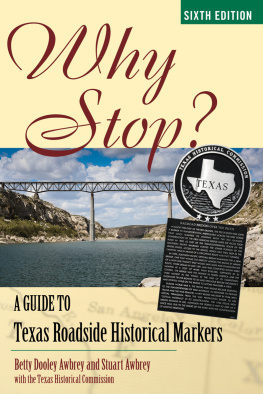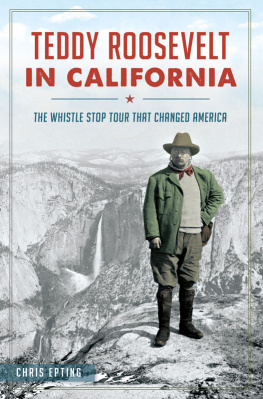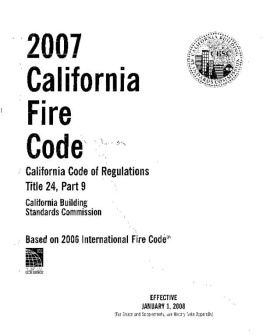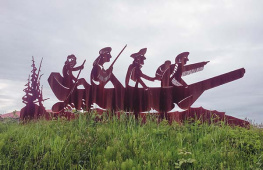
A Guide to California
Roadside Historical Markers
Marael Johnson

Dedicated to
the many organizations
who have worked to preserve
the rich history of California
California
Why Stop?

A Guide to California Roadside Historical Markers
Copyright 1995 by Gulf Publishing Company, Houston, Texas. All rights including reproduction by photographic or electronic process and translation into other languages are fully reserved under the International Copyright Union, the Universal Copyright Convention, and the Pan-American Copyright Convention. Reproduction or use of this book in whole or in part in any manner without written permission of the publisher is strictly prohibited.
GULF PUBLISHING
An Imprint of the Rowman & Littlefield
Publishing Group
4501 Forbes Blvd., Suite 200
Lanham, MD 20706
Distributed by National Book Network
Library of Congress Cataloging-in-Publication Data
Johnson, Marael.
California, why stop? : a guide to California roadside historical markers / Marael Johnson.
p. cm.
Includes bibliographical reference (p. ) and index.
ISBN 0-88415-923-X
1. Historical markersCaliforniaGuidebooks. 2. CaliforniaGuidebooks. 3. CaliforniaHistory,
Local. I. Title.
F862.J69 1995
917.940453dc20 95-7747
CIP
Printed in the United States of America.
Acknowledgments

Many thanks to the California Department of Parks and Recreation State Historical Resources Commission and Sandra J. Elder, Assistant Executive Secretary, for making their files available and for their courtesy and cooperation in compiling this book, and also to Dr. Eugene Chamberlain (Squibob Chapter of E Clampus Vitus).
I also wish to extend grateful acknowledgment to AMTRAK, whose trains and buses offer service to many of the historical landmark areas, for generous assistance with the research of this book.
Preface

California must certainly qualify as the most diverse state in the nation. Its nearly 160,000 square miles spin a kaleidoscope of ethereal mountain ranges, majestic forests, lush valleys, rushing rivers, placid lakes, and arid deserts, all prismed by Mt. Whitney (the lower 48s highest peak) and Death Valley (the countrys lowest point). Within this landscape are renowned vineyards, historic gold rush towns, Spanish missions and adobe dwellings, low-key San Diego, ritzy-glitzy L.A., super-sophisticated San Francisco, and more than 1,000 miles of Pacific coastline ranging from golden Riviera-esque sandy shores in the southern half of the state to dramatic wild seas and pounding waves in the northern part.
Along the highways and byways crisscrossing this geographical and cultural phantasmagoria, you will encounter most of the states 1,013 official historical markers. Why Stop? A Guide to California Roadside Historical Markers enables you to experience the whole plethora of Californias historical eventsfrom Junipero Serras benevolent missions to Mark Twains jumping frog visions, whether relaxing in your armchair or whooshing past in your car. Why Stop? can also be a useful planning tool for your California trip, allowing you to pick and choose routes and destinations before leaving home. Ride along the pony express route one day, relive gold rush excitement the next, and visit prehistoric tar pits on another. Most state and local tourist organizations can provide additional information on marker sites, and many towns and cities publish walking-tour maps of heritage areas. To the best of my knowledge, inscriptions contained herein are identical to wording on the actual plaques. Any errors are unintentional and, upon notification, will be corrected in future editions. Additionally, markers occasionally are relocated (usually due to highway construction) or removed by vandals. Again, upon notification, errors will be corrected. Enjoy Why Stop?. Discover the rhyme, the rhythm, the hymn, and the hum. California, here you come!
Marael Johnson
About California Historical Markers...

The official landmark program, instigated in 1931, originally was administered by the California State Chamber of Commerce with individual evaluations made by the Historic Sites Marking Committee, a group of prominent California historians. Once the sites were approved, the Division of Highways of the Department of Public Works erected the plaques.
In 1948, the California Centennial Commission, appointed by the State Legislature in the centennial year of gold discovery, took over the program. A year later, Governor Earl Warren established the California Historical Landmarks Advisory Committee to ensure quality control of the marker program. For some years, the California State Park Commission had final say-so.
In 1974, the California Historical Landmarks Advisory Committee became known as the State Historical Resources Commissionan advisory body of the California Department of Parks and Recreation and current overseer of official historical landmarks.
To qualify as an official landmark, the site must meet the following criteria: It is of lasting significance to the states history; it is of significant historical importance to the state; it is a historic trail or route; or it is a significant architectural landmark.
The nine-member advisory committee which reviews each application includes a historian, architectural historian, architect, historic archaeologist, prehistoric archaeologist, ethnic historian, folklorist, and two public members.
Thus far, California has a total of 1,013 official historical landmarks. Official plaques, made of brass, sport the California bear symbol flanked by a star on either side. Inscriptions on the plaques are suggested by locals, edited by staff of the State Historical Resources Commission, then returned to locals for approval.
Other official landmarks are designated by plaques made of granite, wood, sandstone, marble, or other materials, and have been placed by civic organizations or patriotic and historical associations such as Daughters of the American Revolution, Sons and Daughters of the Golden West, and E Clampus Vitus.
How To Use This Guide

The marker inscriptions selected for this book have been compiled for the convenience and enjoyment of both the traveler and the history enthusiast. They occur in the order of the alphabetized cities or towns nearest them. By locating the name of the town you are approaching, you can determine the location of nearby markers by the information in italics. Indicated distances are measured from the nearest town within the county in which the marker is located. The index includes 57 California counties and lists the key persons and events responsible for the markers.
HIGHWAY AND ROAD LEGEND:
Next page










